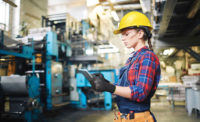My first recollection of the harm a dropped object can cause was in my youth when touring the Empire State Building in New York City. I remember over-hearing, “If you drop a penny or pen from the Empire State Building and it lands on someone, it could kill them.” You may have heard this anecdote too.
For some reason, that stuck with me — how something so small, like a penny or ballpoint pen, could turn into a dangerous weapon when dropped from a height.
The Empire State Building is 1,250 feet tall, so it was easy to believe what I overheard. I have since learned that because a penny’s lightweight, flat round shape, and the fact that it experiences a lot of air resistance would most likely not kill someone if tossed from the Empire State Building.
However, according to Louis Bloomfield, physicist at the University of Virginia, “falling ballpoint pens are the real danger. If someone nonchalantly tossed one of those off the top of the Empire State Building, it could kill.”
Depending on their design, pens will either spin and flutter, or shoot down like an arrow. In the latter case, "it might well come down at 200 mph," Bloomfield said. "When it hits, it will hit a small area with a lot of momentum. It will chip the sidewalk. It could punch into a wooden board. You wouldn't want it to hit your head."
Lots of shapes and sizes
In addition to ballpoint pens, hand-held radios, cell phones, or tape measures can also injure people below if dropped from a height. Heavier objects like a sledge-hammer, wrench, or drill are even more problematic. Then there are tool buckets, paint cans, bricks, boards, and wire spools that can easily fall and hurt workers and pedestrians walking below, especially at high-rise construction sites.
Both the object’s weight and shape and the height from which it was dropped contribute to the severity of a potential injury. The severity of injuries and damages is increased if the object is aerodynamic, heavier, or higher up. Sleek, thin objects pose a problem because of their aerodynamic nature, compared to objects that are flat or have several edges.
Dropped objects come in lots of shapes and sizes and are divided into two types: (1) Static and (2) Dynamic.
A Static dropped object falls without any applied force because it falls from its previous position under its own weight. Corrosion, vibration, or lack of proper maintenance are often the culprits in a static dropped object.
A Dynamic dropped object falls from its previous position due to applied force. This force could come from moving equipment that bumps into scaffolding, stacked items, or dislodged tools or equipment.
Bottom line, if an item falls from a height and causes equipment damage, personal injury, or a fatality, it is considered a “dropped object incident.”
Common injuries
Falling objects can cause devasting and catastrophic injuries, such as:
- cuts and gashes
- eye injuries
- crushed and broken limbs
- paralysis
- head trauma like a fractured skull
- brain injuries
- neck, back, and spinal cord injuries
- death
The cost of drops
Mitigating dropped object risks can be challenging but should be proactively pursued, especially in industries where the risk of objects falling from height are an ever present danger. These include utility, construction, oil and gas, mining, marine, offshore industries, power generation, and renewable energy. Big-box stores and warehouse retailers have seen increases in dropped object injuries from the nature of their set-up with boxes stacked several feet in the air on both sides of the aisles.
Pursuing dropped object solutions is important because it protects people, but it also protects a company’s financial performance and reputation.
The negative publicity from a dropped object fatality can quickly soil a company’s reputation. Plus, the legal battles that can erupt can drain financial resources, especially when the public is involved. Should a fatality occur at work, its emotional impact carries over to employees who worked with the deceased possibly creating psychological challenges among the crew.
Productivity also suffers when tools or equipment need to be retrieved. If a tool can’t be retrieved because it has fallen into other machinery or if it becomes damaged, the job may not be completed on time.
An injury every 10.5 minutes
OSHA says there are over 50,000 “struck by falling object” incidents every year in the United States. It’s hard to believe it, but that means someone is injured by a dropped object every 10.5 minutes, which means almost 140 people are struck by a falling object every day in the US. Here is the math.
- 60 minutes x 24 = 1440 minutes in a day
- 1440 x 365 days = 525,600 minutes in a year
- 525,600 minutes divided by 50,000 injuries = one injury every 10.5 minutes
- 1440 minutes divided by 10.5 minutes = 137 people who are struck by a falling object every day in the US.
Because objects falling from heights are a major safety risk, a new standard was launched in 2018 for dropped object prevention.
The ANSI/ISEA 121-2018 Standard for Dropped Object Prevention
ANSI/ISEA 121-2018 is a voluntary consensus standard launched in the summer of 2018. It establishes:
- Minimum design requirements
- Performance and labeling requirements
- Guidelines for testing
Since it is a voluntary consensus standard for safety products, it is not directly enforceable by regulatory bodies like OSHA. However, OSHA does require that employers address falling/dropped objects hazards on the job. OSHA mentions this in General Industry (1910.23; 1910.28) and Construction (1926.451; 1926.501; 1926.759) standards. This establishes that OSHA does require mitigation of falling/dropped objects risk and can cite a company via:
- ANSI and other consensus standards
- the General Duty Clause
- a Letter of Interpretation
Drawbacks to the standard
The standard does not specify what needs to be tethered or when it needs to be tethered. These are usually specified by a company or a regulatory body. Plus, the standard does not specify proper use of the equipment because proper use is specified by the manufacturer.
Despite these drawbacks, the standard guides manufacturers, employers, and workers toward safer solutions and increases the awareness that string and duct tape aren’t good choices for tethering objects.
ANSI/ISEA 121-2018 is considered a groundbreaking standard and is just as important to dropped object prevention PPE as the ANSI Z359 standard is to fall protection equipment.
What types of equipment does the standard cover?
The adoption of ANSI/ISEA 121 as a general standard provides concrete definitions of the equipment the standard covers. The terms below promote clarity and consistency in the workplace when discussing dropped object prevention. The major equipment categories are:
- Anchor attachments: These allow a tool to be tethered to someone or something. They’re also retrofitted attachment points, but to a fixed anchor location (such as a structure) or a worker.
- Tool attachments: Defined as any retrofitted attachment points that are fitted to tools or other equipment to enable them to be tethered.
- Tool tethers: The tool lanyards that tether the equipment to an anchor point.
- Containers: Any container that can be used to transport tools, equipment or parts to and from work areas at height. This can include bags, buckets, and pouches.
Integrated tool tether and anchor system
Although not widespread in the industry yet, one emerging solution that helps prevent tool drops is using an integrated tether vest and retractor system for smaller tools.
This type of system prevents objects from dropping but also secures the tool and the tether in heavy-duty grommeted anchor pockets inside the vests when tools are not in use. This prevents the tether from entangling and possibly causing a worker to lose his or her balance, which could result in the worker falling or tripping. This type of system is ideal for tools and accessories that weigh three ounces to two pounds.
“Since the tether and tool disappear when contained in the pocket, workers won’t drop tools. Plus, the tether won’t snag or catch on nearby items, causing workers to lose their balance, which is often the case with fixed-length tethers,” said PPE product manager Nicole Novick, who is actively involved with the ISEA task force on dropped object prevention.
There is a learning curve with retractable tool tethers. Employees will need to be properly trained on how to use them. They will need to learn how to attach the tools, use the lanyards correctly, and respect the weight rating of the lanyards. Most manufacturers who supply tethers have videos and training aids to help with employee training.
Why are dropped objects under two pounds a problem?
Perhaps a tool under two pounds seems insignificant when workers are already overwhelmed from the hazards of operating heavy machinery or from working in elevated or tight spaces.
Is it because tool drops of objects two pounds or less are not the obvious risk, so the prevention of them stays on the back-burner?
No matter the reason, just as numerous precautions are taken to keep workers from falling off forklifts and scaffolding, there needs to be more focus on preventing their every day work tools and accessories from falling on others.
Wherever people are working on elevated surfaces and other people are walking below, there is the potential for a falling object accident. But there is also an opportunity to use an integrated tool tether system to help prevent the incident from occurring in the first place.









